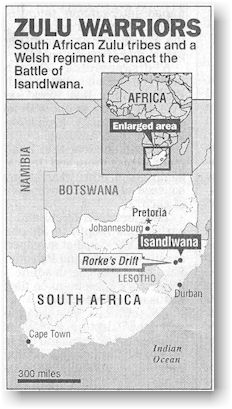
Zulus, British re-enact 1879 battle
By Christine Dolan, 1/20/00 Washington Times
ISANDLWANA, South Africa
At dawn on Jan. 22, a single bugle blows as the 23rd Welsh Regiment marches down the road to Isandlwana from Rorke's Drift, a historic British outpost about three miles away.

Marching in silence, listening to their commander's voice, they advance up and down hills over unpaved roads, passing rambling tin shacks with a few poorly dressed children looking on with utter bewilderment.
Traditionally, the second week in January is the time when the African Zulu tribes gather before their king to celebrate the ushering in of the new harvest, known as the Umkhosi ceremony. Zulus make up 30 percent of South Africa's 30 million people.
One week after that gathering in 1879, there came a battle that changed the course of Zulu and British history in South Africa.
Now that battle is re-enacted every Jan. 22 in an homage to the Zulu tribe, known as the People of the Heavens, and the British forebears who fought and died in the Anglo-Zulu War. The battles are still talked about today.
The 24,000 Zulus utterly defeated the British at the Battle of Isandlwana, killing more than 1,800 men, including the six full companies of the Second Warwickshire Regiment.
The victory broke the British myth of invincibility, even though 1,000 Zulus were defeated by 150 British soldiers at Rorke's Drift later that same day. Rorke's Drift is about three hours' drive from Durban in northeastern South Africa.
In 1879 the regiment had no path for the march to Isandlwana, as do the modern soldiers. They made their way over rocks, boulders, grass, and plains marching uniformly toward this town whose name means "looks like a hut."
In the distance, as if cued by a director on a movie set, another group of small figures begins to move toward the town. They draw closer, clad in leopard skins and carrying fearsome spears known as assegais, while issuing a ululating chant. These are the Zulu tribesmen - the young warriors - the amabutho, who are the pride of the nation.
Swirling to the right, the Welsh Regiment appears around the bend, now singing its battle hymn in unison. In the distance is a bolt of bright red contrasting against the and earth tones - the British Redcoats - in white battle helmets marching behind their young buglers. Shoulder to shoulder, they march up and down the hills behind the Welsh Regiment.
Only 60 British soldiers were left standing after the 1879 battles, while 1,000 Zulus were killed and another 1,000 were wounded. More than 20,000 Zulus survived.
Historians say nature made its own mark on this day in 1879. At approximately 2 p.m., the moon passed in front of the sun and the half-light of a solar eclipse fell over the battlefield. It was the end of the battle.

Other photos
Photo #1: "To honor the one-time South African Zulu foes, the British drummer of the queen's colors is draped in leopard skins. The annual re-enactment of the 1879 Battle of Isnadlwana is set to take place Saturday."
Photo #2: "Waving their swords and shields, a regiment of Zulu warriors shout their victory song, 'Thou Great and Mighty Chief.'"
Photo #3: "The British Army aims and fires at the oncoming Zulus streaming from behind a hill."
Photo #4: "Zulu elder chief gives the attack order to his warriors."